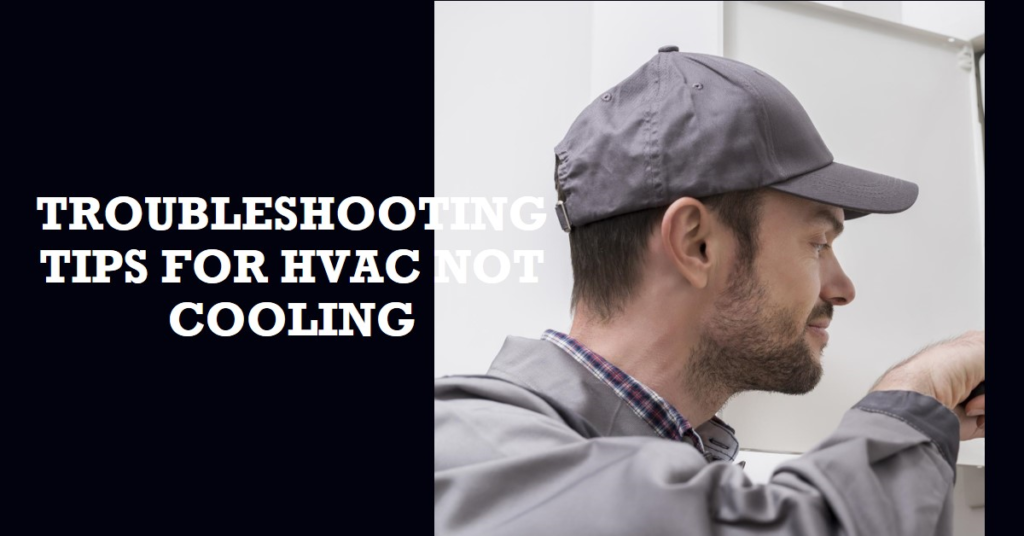
Table of Contents
- Introduction:
- Understanding the Basics of Your HVAC System:
- Common Signs Your HVAC System Isn’t Cooling:
- Inspecting the Thermostat:
- Checking the Air Filter:
- Examining the Air Ducts:
- Inspecting the Outdoor Unit:
- Checking the Refrigerant Levels:
- Assessing the Blower Motor:
- Evaluating Electrical Components:
- Scheduling Professional Maintenance:
- Knowing When to Replace Your HVAC System:
- Conclusion: Restoring Comfort and Efficiency
Introduction:
When your HVAC system isn’t cooling, it can quickly turn your home into an uncomfortable environment, especially during the sweltering summer months. Understanding the potential causes and solutions can save you time and money. This guide offers a detailed look into troubleshooting tips to get your HVAC system back on track.
Understanding the Basics of Your HVAC System:
Before diving into troubleshooting, it’s essential to grasp the basics of how your HVAC system operates. The HVAC (Heating, Ventilation, and Air Conditioning) system is designed to regulate the temperature and air quality in your home.
An HVAC system consists of several components, including the thermostat, air handler, evaporator coil, condenser, and refrigerant. Each part plays a crucial role in maintaining a comfortable indoor climate. When one component fails, it can disrupt the entire system’s functionality.
Common Signs Your HVAC System Isn’t Cooling:
Recognizing the signs that your HVAC system isn’t cooling properly can help you address the issue promptly. One obvious indicator is when the air coming from the vents is warm or only slightly cool. This can be frustrating, especially if you’ve set the thermostat to a lower temperature.
Additionally, if your HVAC system runs continuously without shutting off, or if it frequently cycles on and off, these could be signs of underlying issues. Unusual noises, such as grinding or squealing, or strange odors emanating from the vents, also signal that something might be wrong.
Inspecting the Thermostat:
The thermostat is the brain of your HVAC system. If it’s not functioning correctly, it can lead to cooling problems. First, ensure that your thermostat is set to the correct mode (cooling) and that the temperature setting is lower than the current room temperature.
Check if the thermostat’s display is active. If it’s blank or unresponsive, the issue might be as simple as dead batteries. Replacing the batteries could resolve the problem. Additionally, make sure the thermostat is clean and free of dust, which can affect its performance.
Checking the Air Filter:
A dirty or clogged air filter is one of the most common reasons for HVAC cooling issues. Air filters trap dust, dirt, and other particles, preventing them from entering your HVAC system. Over time, these filters can become clogged, restricting airflow and reducing the system’s efficiency.
To check the air filter, locate it within your HVAC system, typically near the return air duct. Remove the filter and inspect it for dirt and debris. If it appears dirty, replace it with a new one. Regularly changing your air filter, usually every one to three months, can prevent cooling problems and improve air quality.
Examining the Air Ducts:
Air ducts play a vital role in distributing cooled air throughout your home. If they’re damaged or blocked, they can impede airflow and reduce cooling efficiency. Start by visually inspecting the exposed ducts for any visible signs of damage, such as holes or leaks.
You can also check for blockages by removing vent covers and using a flashlight to look inside the ducts. Dust and debris can accumulate over time, causing blockages. In some cases, professional duct cleaning may be necessary to ensure optimal airflow and cooling performance.
Inspecting the Outdoor Unit:
The outdoor unit, or condenser, is responsible for releasing the heat absorbed from inside your home. If it’s obstructed or dirty, it can’t function efficiently. Begin by ensuring there’s no debris, such as leaves or branches, blocking the unit. Clear at least two feet of space around the unit to allow for proper airflow.
Next, inspect the condenser coils for dirt and grime. Dirty coils can’t release heat effectively. You can clean the coils using a garden hose, gently spraying from the inside out to avoid damaging them. For stubborn dirt, a coil cleaner specifically designed for HVAC systems can be used.
Checking the Refrigerant Levels:
Refrigerant is essential for your HVAC system to cool air effectively. Low refrigerant levels can result in inadequate cooling and potential damage to the system. You’ll need a professional HVAC technician to check and refill the refrigerant if needed, as handling refrigerant requires specialized knowledge and equipment.
However, you can perform a basic check by observing the copper lines leading to the outdoor unit. If you notice frost or ice buildup on the lines, it could indicate low refrigerant levels or other issues such as a malfunctioning expansion valve.
Assessing the Blower Motor:
The blower motor is responsible for circulating air through your HVAC system. If it’s not working correctly, your system won’t be able to distribute cooled air effectively. Listen for any unusual sounds coming from the blower motor, such as squealing or grinding, which can indicate a problem.
You can also visually inspect the motor and its components for any visible damage or obstructions. If you suspect the blower motor is faulty, it’s best to contact a professional technician for further assessment and repair.


Evaluating Electrical Components:
Electrical issues can prevent your HVAC system from cooling properly. Check the circuit breakers and fuses to ensure they haven’t tripped or blown. Resetting a tripped breaker or replacing a blown fuse can sometimes resolve the issue.
Additionally, inspect the wiring connections at both the indoor and outdoor units. Loose or damaged wires can disrupt the system’s operation. If you’re not comfortable working with electrical components, it’s advisable to seek help from a licensed HVAC technician.
Scheduling Professional Maintenance:
Regular professional maintenance is crucial for keeping your HVAC system in top condition. During a maintenance visit, a technician will thoroughly inspect and clean all components, check refrigerant levels, and identify any potential issues before they become major problems.
Scheduling annual maintenance, ideally before the cooling season begins, can prevent unexpected breakdowns and ensure your system operates efficiently throughout the year. It’s an investment that pays off in the long run by extending the life of your HVAC system and maintaining optimal performance.
Knowing When to Replace Your HVAC System:
Despite your best efforts, there comes a time when repairing an HVAC system is no longer cost-effective. If your system is over 15 years old, requires frequent repairs, or fails to maintain a consistent temperature, it may be time to consider a replacement.
Modern HVAC systems are more energy-efficient and can provide better cooling performance, potentially lowering your energy bills. Consulting with a professional HVAC contractor can help you determine the best options for your home and budget.
Conclusion: Restoring Comfort and Efficiency
Troubleshooting your HVAC system when it’s not cooling can seem daunting, but with these comprehensive tips, you can identify and resolve many common issues. Understanding the basics, inspecting key components, and knowing when to seek professional help are essential steps in maintaining a comfortable and efficient home environment.
Regular maintenance and timely repairs not only ensure your HVAC system operates smoothly but also prolong its lifespan, providing you with reliable cooling for years to come. By taking proactive measures, you can keep your home cool and comfortable, even during the hottest months of the year.



